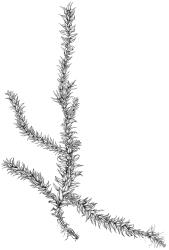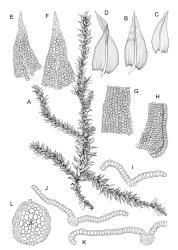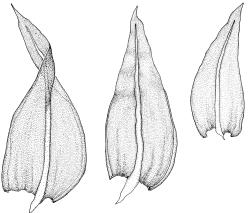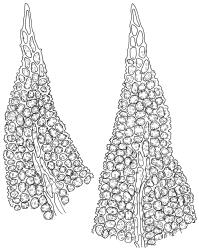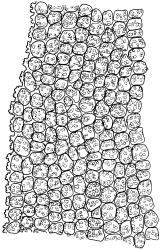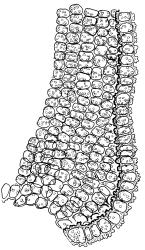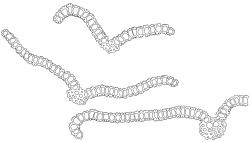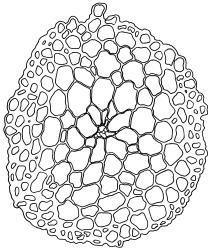- ≡ Anomodon tasmanicus Broth., Öfvers. Finska Vetensk.-Soc. Förh. 42: 121 (1900)
- = Triquetrella curvifolia Dixon & Sainsbury, J. Bot. 71: 217 (1933)
Plants green, forming interwoven mats of catenulate shoots on soil. Stems green to brown, bearing copious tufts of smooth, red-brown rhizoids on older parts, in cross-section rounded, with central strand and sclerodermis present. Leaves in three straight ranks (not spiralled), erect-spreading when moist, ± secund, incurved and flexuose-twisted with apices often oblique when dry, 0.5–1.0 mm, ovate-triangular, weakly carinate, acuminate with a distinct hyaline apex, base not decurrent; margins ± recurved in leaf base, plane above, crenulate from bulging cells and papillose; upper laminal cells obscure, quadrate, firm-walled, (6.0–)7.5–9.0(–10.5) × 6.0–9.0(–10.5) µm, pluripapillose with low, complex papillae obscuring cell lumen; upper marginal cells not differentiated; lower laminal cells not differentiated, even at extreme leaf base. Costa concolorous, glossy, failing c. 10–15 cells below the leaf apex. Laminal KOH colour reaction yellow.
Dioicous? Perichaetia terminal; perichaetial leaves acuminate, with laminal cells smooth. Perigonia and sporophytes not seen.
Malcolm et al. 2020, p. 648.
The catenulate form of the dry shoots is reminiscent of those species of Thuidiopsis and Thuidium that are robust; namely Thuidiopsis furfurosa, Thuidium cymbifolium, and Thuidium laeviusculum. Triquetrella tasmanica can be distinguished by its irregular branching pattern (vs pinnate in Thuidium and Thuidiopsis spp.) and the absence of stem paraphyllia (present, at least on main stems, in Thuidium and Thuidiopsis spp.). Confusion may also occur with species of Racopilum, but the failing costa of Triquetrella tasmanica will distinguish them (vs costa long-excurrent in Racopilum spp.).
NI: Hawke’s Bay (Havelock North); SI: Otago.
Australasian. Tasmania*, mainland Australia*.
On earth or rock, exposed or shaded among grasses, from 30–550 m (Taieri Ridge, Otago L.D.). This poorly documented species appears to be confined to drier parts of the country. Associated moss species include Bryoerythrophyllum dubium, B. recurvirostrum, Bryum argenteum, Gertrudiella torquata, Hypnum cupressiforme, Leptodontium interruptum, Pseudocrossidium crinitum, and Weissia austrocrispa.
Triquetrella tasmanica was originally described by Brotherus (1900), from Tasmanian material, as a species of Anomodon in the Thuidiaceae. The later synonym, T. curvifolia, was published by Dixon & Sainsbury (1933), based on a N.Z. type. However, Sainsbury later accepted these two names as synonyms (Sainsbury 1955) and noted that although the generic position could not be considered as established in the absence of fruit, it was probably an Anomodon. More recently, the discovery of terminal perichaetial buds (Granzow-de la Cerda 1989), which are present in both the WELT isotype and in N.Z. material from Mt Iron, Otago L.D. (J.E. Beever 96-25, CHR 612371), supports placement in the Pottiaceae.



